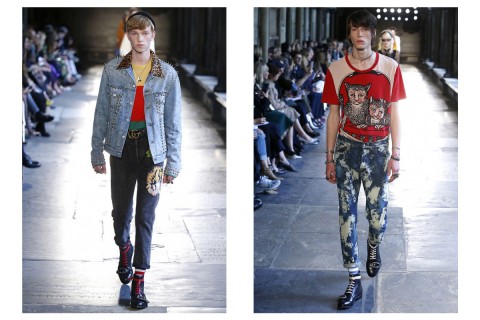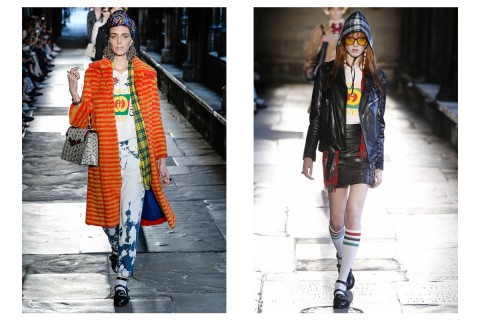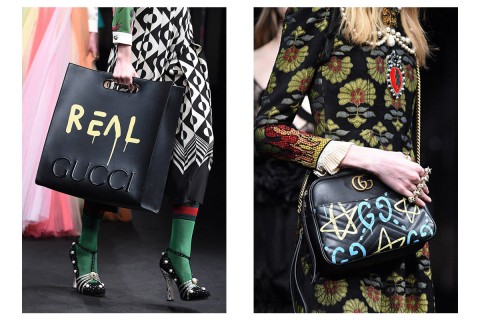Few fashion success stories are as notable as that of Alessandro Michele. Gucci’s critically-acclaimed creative director first stepped into his role around 18 months ago, quickly making a lasting impression on the notoriously fickle fashion industry. His career has since gone from strength to strength: the designer courted fans by eroding the flashy glamour that previously defined the Italian brand, instead introducing his romantic, bohemian vision to the then-struggling house.
This vision is amongst the most celebrated and distinctive in the landscape of today’s fashion industry, and it’s one that’s disarmingly consistent. Over the course of his tenure Michele has developed certain house codes, and they recurred throughout his recent SS17 Menswear show in the form of ’70s silhouettes, heavy embroidery and trippy paisley prints.
But things are slowly changing at Gucci. In a collection of colored velvet and floral embellishment, this season’s standout piece was a tee that, to the untrained eye, appeared counterfeit. FW16 was similarly surprising, comprised of expensive handbags and leather jackets spray-painted with the word “REAL” by artist GucciGhost, who caught Michele’s eye by spraying “Gucci” onto a series of random clothing and objects.
vogue/getty
These subtle elements of subversion and rebellion were particularly pivotal in the context of an Italian house that hadn’t seen controversy since the heyday of Tom Ford, who reigned supreme with his sex-soaked aesthetic over a decade ago. The prices may still be eye-watering, but Gucci is no longer synonymous with obvious glamour. Instead, the brand is slowly cultivating a reputation as the runway champion of outsider spirit.
It’s easy to pinpoint last season’s menswear show as the definitive turning point for the brand. It’s not unusual for fashion houses to stage “Snapchat takeovers” before a show to build online momentum: these coveted gigs have become a subtle way for brands to align themselves with certain characters and unofficially declare the season’s “muse.”

Vogue
Michele seized this opportunity last season, casting trans trailblazer Hari Nef in her first high-profile runway appearance at FW16 Menswear. It was no real surprise – Nef is hugely respected in her own right, having already fronted & Other Stories’ ad campaign and walking for the likes of Eckhaus Latta and Hood by Air before landing her Gucci debut. Nevertheless, there was something inspiring about seeing a trans model gaining mainstream recognition: her appearance garnered countless column inches and cemented Michele’s progressive intentions.
Ambivalence towards gender is a key component of Gucci’s modern makeover. Media outlets have been quick to throw around terms such as “androgynous” and “gender-fluid,” but it seems that Michele is simply more concerned with creating beautiful clothing than he is with gender-specific marketing.

Getty Images
He reinforced this point when he recently announced that, from next year onwards, “Menswear” and “Womenswear” shows would be merged and that the first unified collection would be shown at Gucci HQ at the start of 2017. The designer may not be the first to take this approach – Vetements, Tom Ford, Burberry and countless others are reconsidering their presentations – but there’s something unquestionably refreshing about such an iconic house disrupting the industry’s rigid rules.
This same style of disruption was evident at the recent Cruise show, which saw Michele make surprisingly literal reference to subcultural hotspot Camden Market and dandy hangout Carnaby Street in his show notes and backstage interviews. The presentation took place under the storied cloisters of Westminster Abbey, a venue choice which made perfect sense given the collection’s prevailing aesthetic; a clash of tradition and modernity.

Acid-washed denim, Union Jack jumpers and studded jackets may have appeared cyclically on the runway since the punks made their cultural mark in the 1980s, but they were still a surprising addition to the Gucci runway. Moreover, they seemed further proof that the awkward, rebellious teenager is slowly becoming the ultimate Gucci muse. The collection gave us the most literal references to youth culture since Michele stepped into the role and served as definitive evidence that the brand finds its inspiration firmly outside the mainstream.
The spirit of punk also bled into Gucci’s new marketing strategy. A “Do It Yourself” service was recently announced, allowing customers to customize pieces and stamp their own identity on the looks. It’s a bit like when you used to sew band patches onto your denim shirts and hack off the sleeves but much, much more chic – and a few grand more expensive, obviously.
Only the Dionysus bag is currently available for modification, but shoes and selected ready-to-wear pieces will be rolled out in the near future, and clients will be able to change the color and trim of their designs, as well as choosing from an array of animal embellishment (imagine a leather jacket with a bejeweled serpent on the back) and a monogram service.

Vogue
These pieces may be hugely expensive, but it’s still refreshing to see a designer toy with a more radical approach to design. It’s a reminder that fashion should be a reinforcement of its wearers’ identity as opposed to a byproduct of an increasingly homogenized industry. By encouraging consumers to “do it themselves,” Michele is reintroducing the element of fun into fashion.
Now, more than ever, it’s fairly easy to replicate the Gucci look – attach a faux fur trim to your favorite loafers, invest in a few animal embroidery kits and screen-print your own Gucci tee and you’re basically good enough to be in the gang. This ease of replication was arguably the reason why the hiring of GucciGhost was seen as a hugely controversial move – brands often employ mammoth legal teams, spending millions to scour the streets for counterfeiters that could sabotage house profit. For Michele to openly acknowledge – and, even more surprisingly, embrace – the counterfeit trade is a decision which continues to baffle many, but it does prove that the definition of luxury is changing within fashion.
Savvy shoppers are now more likely to drop €800 on a Vetements hoodie than they are on an evening gown; likewise, Gucci’s “authentic fake” tees will likely be the collection’s biggest seller. The prevalence of these designs are proof that today’s industry is less focused on ostentatious luxury and more on signature “cult” pieces. The idea is to buy into a cult brand and make it part of your own identity.

Gucci
It’s encouraging to see Michele embrace recent changes in the industry, mainly because he’s one man in fashion with the power to influence the way that we think about and experience clothing. He’s caused many an aging editor to rethink their views on gendered runways; he’s shown that iconic brands can play with their core DNA without facing a backlash; and, most importantly, he’s using his own success to spotlight unconventional stars and, in turn, diversify the fashion industry.
It’s still a stretch to label the designer “punk” – Gucci retail prices are hardly accessible, with some pieces selling at upwards of €5,000. But there is an outsider sensibility that sets Michele apart from his contemporaries. He’s deliberately played with ideas of authenticity to challenge the concept of luxury and introduced “cat lady” jumpers and clunky loafers to a brand renowned for its sex appeal. This, in itself, was a risky move that paid off in spectacular fashion.
Even now, several seasons later, the development of Gucci’s vision remains nuanced enough to keep consumers and editors alike fascinated. The bohemian aesthetic has stayed put, but subtle nods to subculture are slowly creeping in.

Gucci
Moreover, co-ed catwalks and customization programs demonstrate that the creative director is as creative with his business plan as he is with his designs, which particularly interesting considering the fashion industry’s current state of flux.
Michele is one of the few designers capitalizing on this period of transition and using it to build a truly authentic brand which balances outsider spirit with commercial viability, and for that he fully deserves the critical acclaim that continues to come his way.
Now check out whether Vetements is having an identity crisis.
-
Words:
Jake Hall -
Lead image:
Fashion Industry Broadcast

